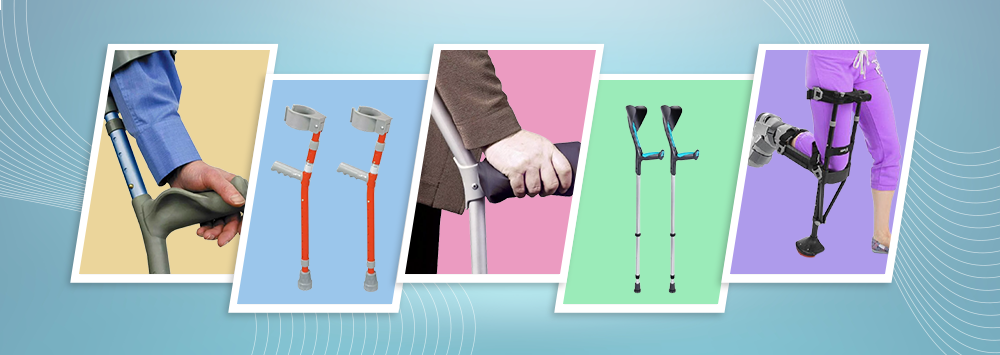
Putting your Best Foot Forward
Sally Madeley-Carr, OT29 Aug 2022
Getting from one point to another is so important in our everyday lives, whether it's moving around the kitchen to prepare food, going to bed, popping to the toilet, or going to work or the shops.
When mobility is affected due to damage to your foot, ankle or leg, a need for some sort of support will arise. Learning how to use crutches may prove to be the way forward, as moving from one spot to another will involve removing or reducing weight on the damaged limb.
It can take a few months to fully recover from such an injury and rehabilitation is then needed, to assist the limb in once again doing its job in managing the weight placed upon it.
Whilst some people may be nervous of using crutches, once the manoeuvre is mastered, crutches prove to be maybe the best way of holding onto your own independence, during your recovery and recuperation.
Different Types of Crutches
There are many types of crutches for sale so, when choosing the right ones for you, you need to know what your difficulty is and what you want your walking support to do for you. A medical assessment will point you in the right direction.
- - Underarm crutches / short-term use (one to three months)
For people recovering from surgery or an injury, underarm crutches demand less upper body strength and are the most recommended model.
The underarm crutch is height-adjustable and the correct height will leave about a two-finger width free between the top of the crutch and your armpit. When walking, don't have the crutches right up to your body but positioned slightly wider than your body width.
When you're standing still, you can lean on your crutches and, when you feel ready to bear some weight onto your affected lower limb, maybe one crutch will prove enough to support you.
The crutch you will continue to use will be the one next to the damaged limb, as it will still be serving as a backup to your support needs.
Incorrect use of crutches can lead to tiredness and discomfort.
- - Forearm crutches / long-term use
For forearm crutches, you need good upper body and arm strength and would be recommended this type of crutch if you have a long-term disability or mobility issue. With time and practice, these crutches can prove easier to use than underarm crutches.
Sometimes referred to as elbow crutches, these are worn by attaching a cuff around your forearm and then gripping the handle, so as to secure your steadiness.
- - Forearm support crutches / to give extra support when walking
These crutches tend to be recommended to people who have chronic pain, or their walking is impeded because of arthritis. Whilst reducing some of the pressure on the body and joints, these crutches can prevent the pain becoming more severe.
These crutches are known under several names, including platform crutches, adjustable arthritic crutches and gutter crutches. The forearms are padded and the handles adjustable, to help the user get the right amount of support they need to walk with confidence.
- - Leg support crutch / lower leg stand-in
Though not truly a crutch, a leg support crutch is something your knee rests on to keep your lower leg bent behind you and out of the way, whilst your knee teams up with the leg support crutch which now acts as your lower leg. This crutch is secured with straps around the calf and up to the thigh, creating a 'full' leg on which to walk and balance.
Taking Steps Forward
How you use your crutches depends on whether you have been measured as non-weight bearing, or weight-bearing.
- - Non-weight bearing means that, during recovery, you must not put any weight on your damaged lower limb.
The crutch on the side of your injured limb becomes that once fit limb. When you move the crutches forward, the damaged limb is bent slightly backwards to keep it off the ground and the crutch on the same side is serving as that damaged limb.
Each time you place the crutches in front of you, make sure that you are placing them only a normal footstep away from you (12 inches / 30 cms.), as overstretching could cause you to lose your balance.
The next step is to bring your functional lower limb forward to align with the crutches.
- - Weight-bearing means that, during recovery, you may be able to put a little weight on your injured limb, though not the full weight, as recovery is still in progress. Imagine you are walking on broken glass and so you are putting maybe only twenty percent of your weigh onto your injured leg.
NB. If both lower limbs have damage, you medical expert will not recommend crutches but may suggest a wheelchair, as neither leg can truly bear your body weight and recovery would be damaged by placing any upper body weight on your lower body and joints.
Mounting Stairs
Mounting stairs or steps might sound mind blowing but, once you know the way to do it, it can be done quite safely. So:-
- If there's a handrail available, use it. Only using one crutch will feel safer to you.
- When using a handrail, you will need to carry both crutches in the other hand.
- Step up with your uninjured leg and then move your injured leg (bent backwards slightly, to stop it touching the step) and the crutches up to the same step.
- Repeat the process till you reach the top.
When you're going down the stairs, follow the same method.
When there is no handrail:-
- Standing on your uninjured leg, place both crutches on the step and then lift your uninjured leg to meet the crutches on the same step.
- Repeat the process for each step and go slowly.
If you feel unsettled with using crutches on stairs and steps, you can get to the top (or the bottom) by sitting on the first step and working your way up(or down) in a sitting position. On public steps, make sure no lift or other means is available, before taking a risk on something you don't feel comfortable with.
Entering and Leaving a Shower
Entering and leaving a shower may see complicated but is rather a straightforward manoeuvre.
Before getting into the shower, make sure you have a shower seat inside the shower on which to sit and also an anti-slip mat on the shower base, as standing and cleansing will otherwise prove extremely difficult, and will be dangerous, on a wet and slippy shower bottom.
Also have a towel available at arm's reach, ready for when you get out of the shower.
Place both crutches on the shower base and then move your uninjured leg inside the shower and onto the base.
Hold onto the shower wall and leave your crutches outside the shower.
Lower yourself onto the shower seat.
Reverse the process to get out of the shower and step straight onto a non-slip mat and into a seat, so as to quickly take the weight of your lower body and dry yourself down.
Safety Tips
When you're using crutches:-
Make sure that you have adjusted the crutch height to be about two finger widths under the armpits
Wear flat shoes, as heels could affect your balance and lead to a fall
Avoid walking on anything on the ground which will be unsteady e.g. rugs, cables, grit and decking
Let your hands take the weight and not your armpits, as placing pressure in your armpits could damage nerves
Don't carry anything in your hands, as this could lead to loss of balance
Make normal length steps when walking, as longer steps could cause you to tilt forward and possibly lose your balance...
SUMMARY
There are many designs of crutches for sale and the right ones for you must be gauged against the injury you have and the medical guidance you receive.
When using underarm crutches, the injured leg is supported by the crutch which is on the same side of the body and so the crutch moves forward in unison with the injured leg.
An underarm crutch should not be right up to your armpit, as such pressure could damage nerves present there. Consult your doctor, if you experience any numbness or tingling.
Non-weight bearing means placing no weight whatsoever on the injured limb during recovery time.
Weight-bearing means that, during recovery, you may be able to put a little weight on your injured limb, though not the full weight, as recovery is still in progress.
Incorrect use of crutches can lead to tiredness and discomfort, as well as further injury.
When going up or down stairs or steps, make use of the handrail, if one is present. This fixed point is good for steadying oneself and makes one feel more in control of the manoeuvre.
When ready to take a shower, preparation is of the essence, to make this task easy and safe.

Sally Madeley-Carr, OT
Sally qualified as an Occupational Therapist in 1996 and is a well-respected professional in the field of rehabilitation equipment and living aids. She has worked in private practice and within the NHS, developing a broad experience with adults and children. Click here for Sally's registration with the Health and Care Professions Council. The HCPC regulates health, psychological and social work professionals in the UK.